Waking up to a techno remix of Feliz Navidad / Merry Christmas song is not the best way to start a day. But François walks me to the exit of Tohun and I am almost instantly at the border posts.
The border crossing is very friendly. I give my Togo flag to the Togolese immigration and we chat a lot once at the Beninese immigration. The officer gives me his laptop to try to fix a software, gives me his phone number, and discusses about anything.
They like the idea of travelling by bicycle, but also say they wouldn’t do it, even if it would be great for the very few kilometers from their home to the office. Why? Because “Africans pay too much attention to what others say“. In this case, people would say “if you are on a bicycle, it means you don’t have the money of the petrol for the morotbike“. And for someone who is not poor, it is almost a duty to look rich.
Out of curiosity, I ask at the two country officials, what if I had crossed the border in Saligbé-Atomey, where there is no control? The Togolese officer ignores my question twice, the Beninese one didn’t know about it, but says I’d probably have problems later. Even for people showing up at this Tohun border without a visa, as it was possible in the past, it would make problems and many calls.
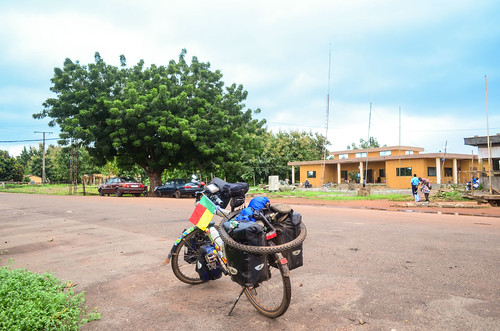
The discussions lasted for a while and the rain comes just when I start cycling again. I don’t have time to avoid getting soaked and wait at a school until the rain stops.


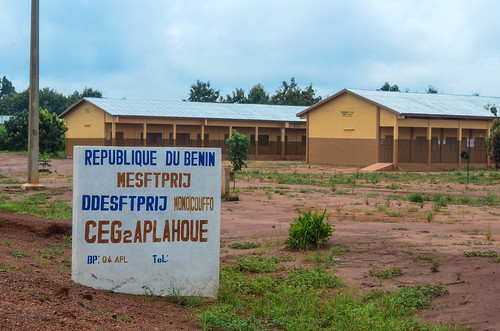
For the first time, I see an information board about the free movement of people within the CEDEAO / ECOWAS area. From Senegal to Nigeria, this West African community of countries looks like the EU: people can move freely with their ID card, no visa needed.
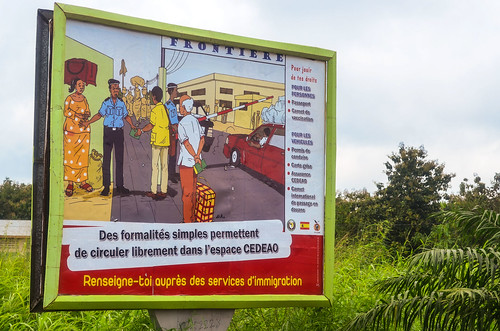
Yet, I have been asked by locals so many times: “Can I travel with you? What do I need? Oh really !? I can go to XXX country without paying?“. Maybe because travelling far from home is not a common hobby here, people are not aware at all of their rights within the CEDEAO. Those who have traveled still pay a bribe at each border to change countries: they are used to, and the border officials ask for it anyway. Bribing seems sometimes deeply rooted into people’s habits.
To get to Abomey, a UNESCO city, I first have to reach the first Beninese town, Azové/Aplahoué. Google Maps is completely wrong just like in Togo.
I buy a local SIM card, which I was used to refer by “la puce” in this part of the world, but they actually say “carte SIM“. I go for MTN without comparing the different operators as I was doing before to find the best deal for internet. The SIM card for a number starting with 66 sells for much cheaper than a SIM card for a 97 number, the historical one.

The mobile phone market is booming in Africa. This graph sums up very well who’s where. As a traveler, my favorite is the South African MTN, Africa’s leading provider who just reached 200 million subscribers, and the only African large operator. The way to buy internet data and to check my credit is pretty consistent through the various countries. It is reasonably priced, works well and quickly. It is sometimes still called Areeba, which is the telecom name of the Lebanese Investcom bought by MTN.
The second biggest player in Africa is the British Vodafone, that I didn’t see much because it is more spread in East Africa. The third largest subscriber’s base belongs to the French Orange, present in 17 countries. Like in Europe, I would rather run away from this one, but sometimes it bought the national operator and inherits the best network coverage. However, the services are not always working and especially there is no consistency across countries. The phone settings of Orange Senegal can be completely different from the settings of Orange Guinée. The only thing Orange seems good at is the repainting of the countryside with Orange-sponsored orange signs everywhere.
The fourth biggest player is the Indian Airtel, but I guess not anymore, since the number 5, the Dubai-based Etisalat (with the Moov brand), just acquired Maroc Telecom and its subsidiaries in 5 African countries.
Among the other operators I have come across in several countries are Expresso (Sudanese), Tigo (Millicom, originally Swedish), Glo (Nigerian). Here is a whole list. I find it interesting because they have more ads than any other sector. Houses and shops are sometimes entirely painted with the colors of an operator. All the sunshades in bars are either yellow for MTN, or black and orange for Orange, or blue for Tigo.
Mobiles phones are everywhere and benefit a certain immunity: if someone receives a call during a museum visit, while he is serving food, driving, or doing business, he will take the call. Nearly everyone has a mobile phone, and even in the remote villages, I am surprised when someone tells me he has no phone. It is also quite cheap for the local living costs. Africa might be the only continent where Nokia still rules, because their basic phones are cheap, robust, and the battery lasts for days. And the same way Africa skipped the “land line telephony step” from being disconnected directly to having a mobile, it might skip the “personal computer step” from paperwork directly to mobile and tablet applications.
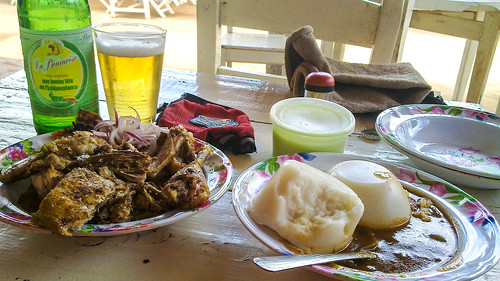
I celebrate my smooth border crossing (and the sun in the back that dried me up quickly) with a small full chicken, with kassa, the maize tasteless paste I had already tried under another name.

I manage to configure my phone for the internet with trial and errors, first getting a ping successful, then a wget, then the email client. I didn’t miss much new without internet for 4 days in Togo.
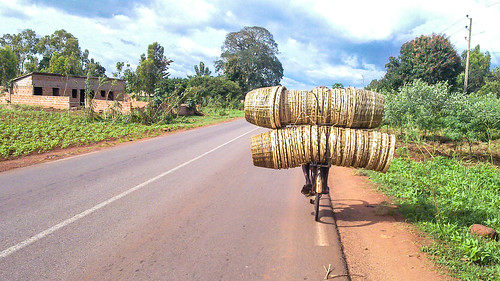
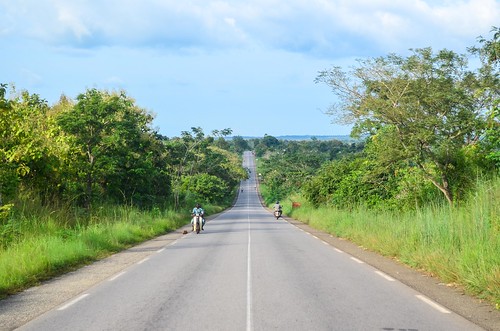
The begging is getting stronger. The Togolese “un petit cadeau?” makes way for the more direct “Donnez-moi l’argent!” by the kids and adults. I still wonder what happens in the heads of the children from seeing a White man to shouting “Give me the money!”.
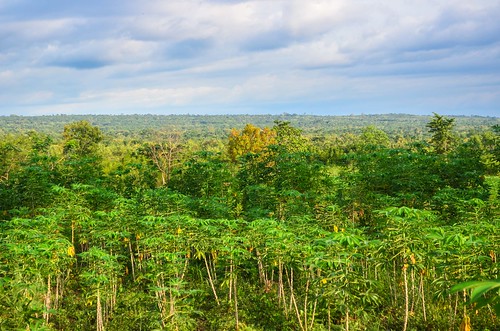
The very nice Azové-Abomey road takes me quickly to the capital of the former Dahomey kingdom. After some roaming in town in order to find an hotel sign (I though it would be easier for one national historical capital) , I finally find the best deal for a clean room with bathroom for 3000 CFA.
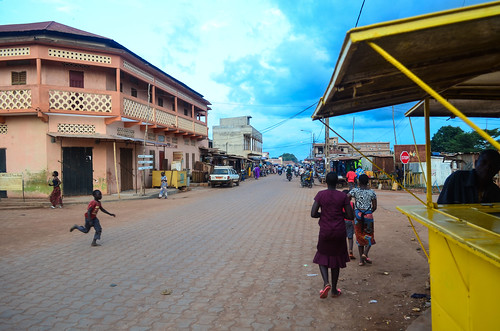
For the dinner, there is not much choice outside. The night-street-food-life is very disappointing. I learn some Fon, the most common language in Benin, with a teenager. At one point, she teaches me the Fon for “Bonne assise”.It is French, but what does this mean? I know that “Bonne arrivée” means bienvenue, but “Bonne assise”? Apparently, one says “bonne assise” after having a good time with someone, sitting chatting or eating, and “bonne assise” is a way to thank the other person for this good time.
Abomey was the capital of the Dahomey kingdom. Even if Dahomey was the former name of Benin, the Dahomey kingdom was only centered around the town of Abomey, and later on until the coast side, after the victory over the Allada kingdom, established by the brother of the first Dahomey king.
From 1625 to 1900, twelve kings have lived in Abomey. They each built their own palace, even if they had already a private one before accessing to the throne, even if the previous kings had built palaces too. As a result, the city seems to have palaces in every street.
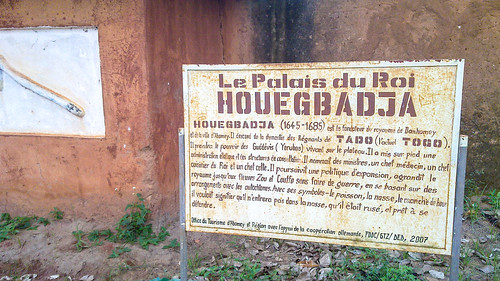
However, most of them are not very attractive. Palaces were large houses made of mud and decorated, but besides the museum, built at the location of two of them, there is not much to be amazed at.
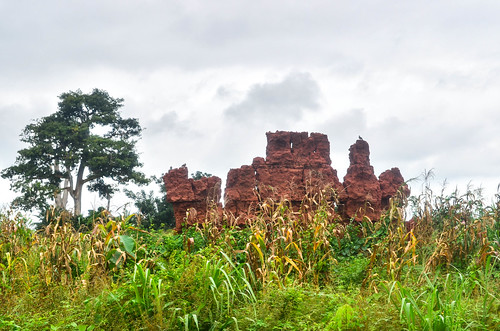
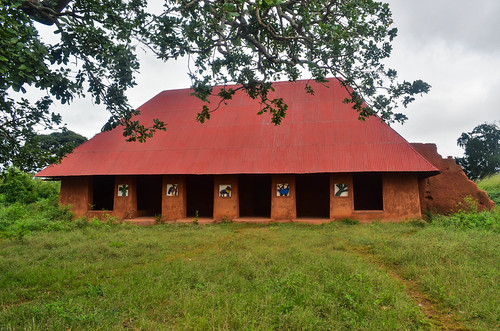
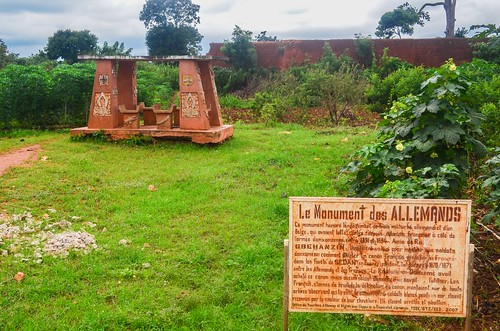
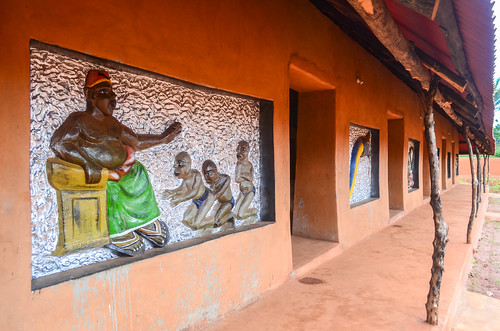
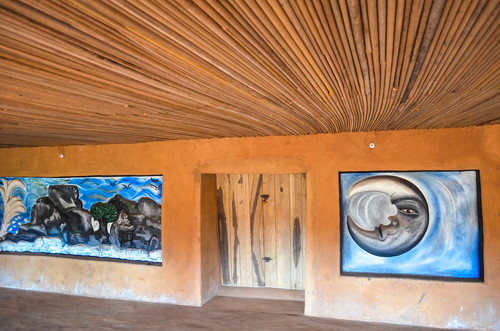
I spend a full day walking in Abomey. This is a primary touristic destination of Benin. The UNESCO label goes along with information boards everywhere to explain the history (although it’s only in French and they don’t seem to enjoy maintenance works). Yet, I have not seen a single other White person. Why are the very few tourists of West Africa sticking to Senegal and Ghana? The other countries are not more unsafe, they are actually more interesting, the food is often better. It just lacks good roads, decent hotels, and sometimes electricity …
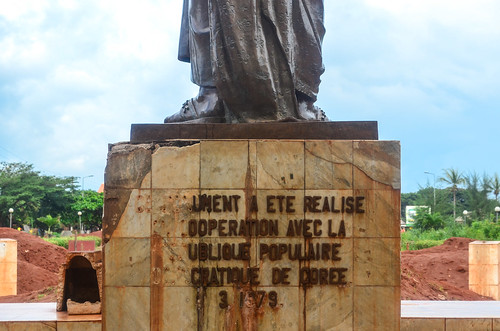
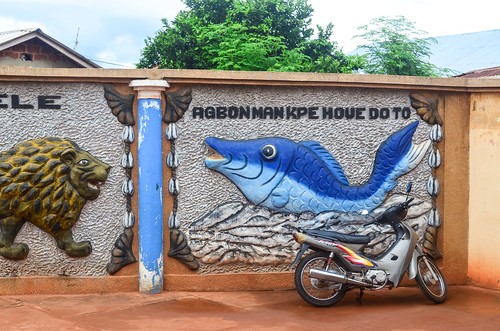
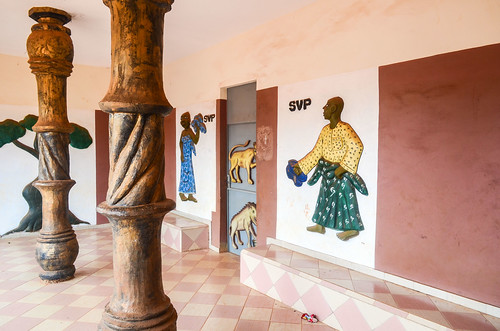
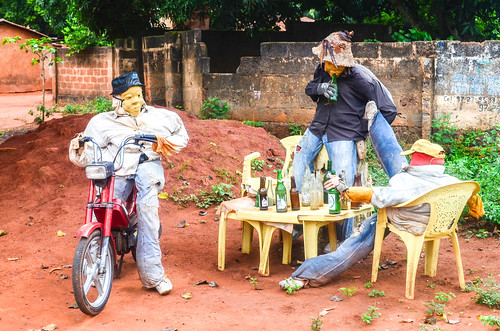
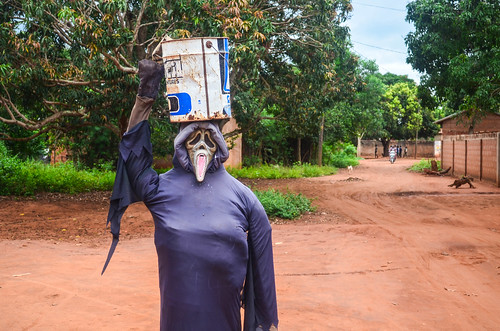
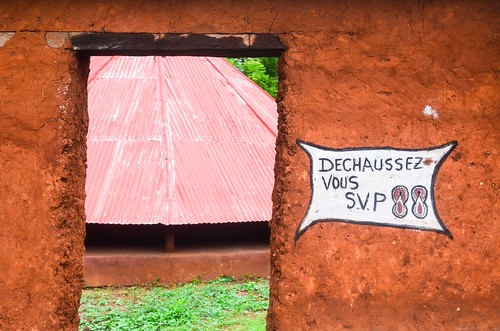
The museum displays canons received by the kings in exchange for slaves. One of the thrones is mounted on skulls of enemies. There is also a fly swatter made of the skull of an enemy and the tail of his horse. There are stories of a wall made with human blood, of a tomb where 41 wives of the king sacrificed themselves to die with him. This is all very bloody, and reminds me of the movie about Liberians soldiers eating the heart of their enemies (their brothers of the past) to gain strength during the civil war (but this was in 2003). The motto of the kings was to leave at their death an empire larger than when they were crowned. This one makes no exception to others in the region, and it worked by trading with the colons, providing slaves for weapons and steel.
I will come back to Abomey later for a deeper insight into the voodoo culture.
The road from Abomey to Cotonou is said to be very bad. I have already been warned several times. Apparently, drivers go through Porto-Novo or through Lokossa, adding more than 50 km to the 140 km journey, just to avoid it.
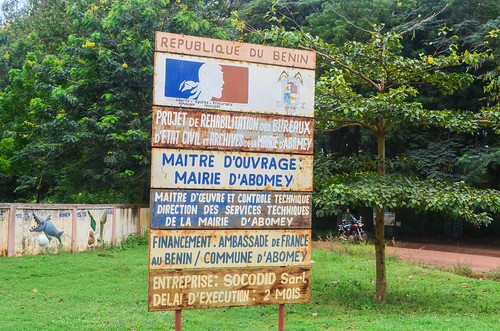
But a bicycle always handles bad roads better than a car. So I head on this straight road. There is quite some traffic, mostly large trucks, so I don’t worry about ending in Cotonou.
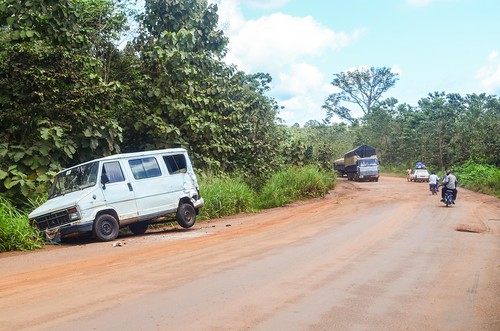
When I see papayas on the road side, I think it would made a nice sugar boost for the journey. I start bargaining for the way-too-high price of 500 CFA (1 USD) for a papaya, until I understand that this is the price for a bucket of papayas.
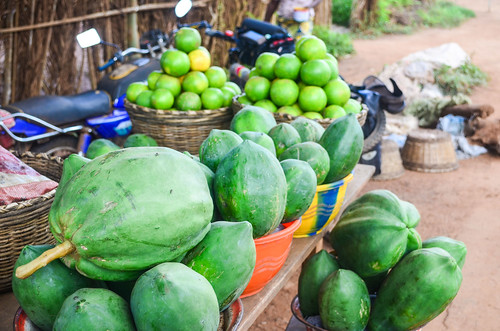
Indeed, they come from the trees just across the road. Since I cannot carry those heavy and huge fruits, I just sit and have an all-you-can-eat session for 500 CFA.
The road is not that bad. It has many potholes indeed, but I can always cycle around.

But the road worsens. Trucks are really more numerous than cars. The potholes are so deep and wide that a normal car wouldn’t be able to go through it. I hear some bad bumpers noises there …
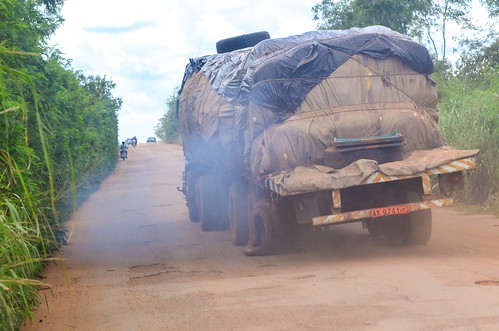
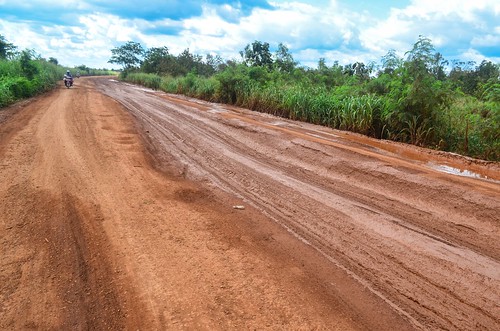
I am seriously faster than the trucks. They have to reduce their speed to almost immobility before driving into the huge potholes. Many of them are broken down by the roadside. The shame is that this road is the main road link between the port of Cotonou (right in the city center, that doesn’t help either) to the north of the country and Burkina Faso, Niger.

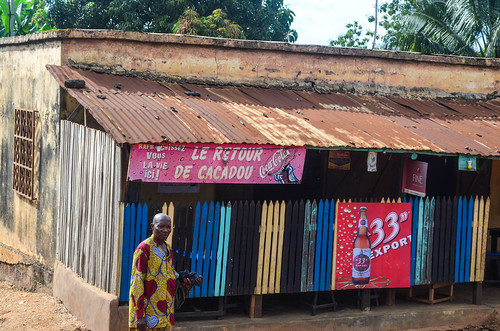
The “yevu” calling for White people is now “yovo” in Fon. The children sometimes sing a song to me, “yovo yovo bonsoir, ca va bien merci” (“yovo yovo hello, I am fine thank you”). Often, “bonsoir” is replaced by “cadeau”. And often, the song is shortened into “yovo cadeau !” (“White, present!”), which makes them sound like Senegalese kids.
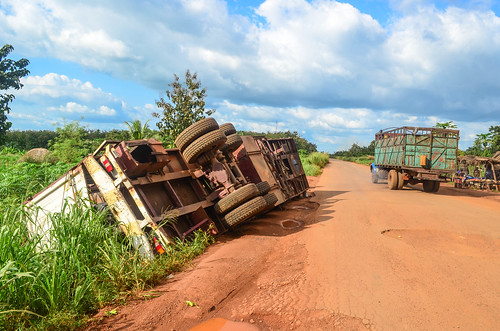
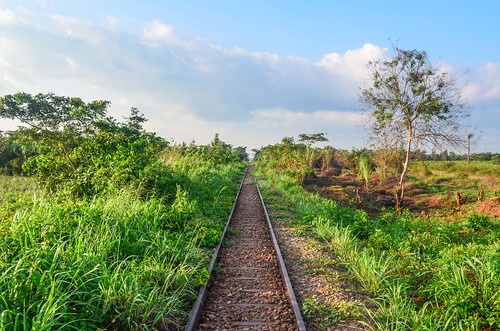
When I was in Togo, I found funny stickers for Togo and Benin. My bicycle frame is now well covered.
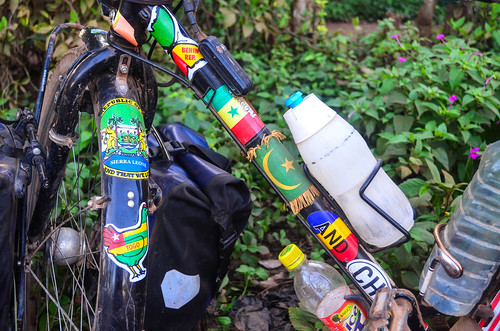
The traffic on the road follows the rule of the best side: you change side when you want to avoid a big pothole (if you can). The motorbikers, and myself, go around the trucks and cars on the right or on the left, whichever seems the fastest. Also, the bigger the vehicle, the priority on the best patches of asphalt. It end up into a lawless race, it has a feeling of bush adventure, but with the truck traffic of a main road link.
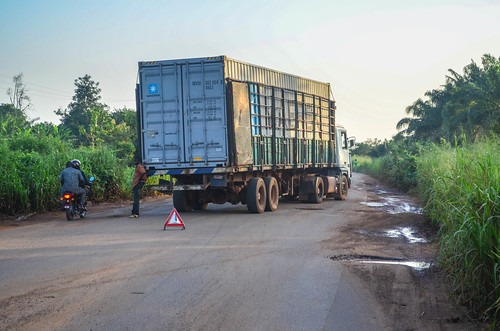
After Allada, I find myself a small guesthouse behind the fields. I walk back to the main road for dinner and find a rice companion. While eating together, he tells me that the factories I have seen, just after Allada, for plastic things and bottling, are Chinese. I would have said Indian from the name (Lakhmi), but it doesn’t matter when people ask me seriously after a fluent French conversation: “Are you Chinese or Japanese?“. What matters is that there are factories in the country, when it is very rare to see industry in West Africa. Jobs are either in agriculture (countryside) or services (capital city). And it seems the little of industry is not locally impulsed. It is always Chinese and Indian. We can question endlessly how is Africa developing by skipping the “industry step”.
I take the opportunity that my new friend is not asking me for money (just my phone number, it’s the next level), and is actually going to college, to continue the conversation.
“The poorest man of your country lives better than the richest in my country“, he says. Really? Then who are all those men in suits in the 4×4 of the African capital cities? In general, I find that the ignorance of the people about their own country is only surpassed by their ignorance of foreign matters. There is no point discussing those topics anyway, it always leads to nowhere. As a side note, one can look for the world’s best paid politicians and see popular African figures showing up (and that is only with the official numbers).
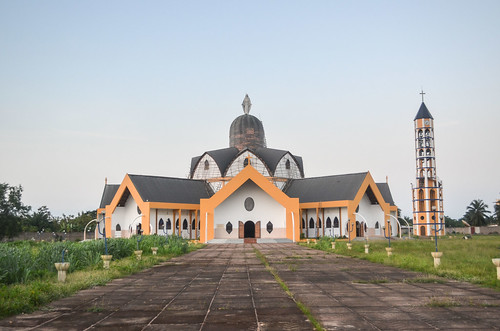
Sometimes, when meeting people, I feel they have more hope into the random White man than into their peers. It’s not completely wrong, as there is probably more chances to receive food and money by begging to a White stranger than by asking to the neighbors.
And while I thought the family links in Africa were strong, it seems I was mistaken. I thought there would be more helping between brothers of a family here rather than in Europe. However, I have been asked many times “Help me to go to your country” by people who already have family in France or in the US. Then why me? We met 5 minutes ago. I was replied that their uncles, brothers, would never invite them or lend a small amount of money to start something. I find that strange, maybe it is in fact just very remote family …
But anyway, living the first world after having left one’s family in Africa must be a hard job. Everyone back home expects presents at each visit. Since this family member is now “rich” (just by being in France, for example), he must help and send money back home. I have seen how hard is the pressure on the first son of the family to feed everyone else, so I can understand that an African who manages to work in Europe doesn’t want to return to his home country. He would be harassed just like a naive tourist.
Well, I have not interacted with all the social categories in the countries I have visited. Since I spend most of my time in the villages and on the road side, eating the cheapest foods and chatting with people working outside, I don’t know much about the world of people driving 4x4s.
To come back to the initial topic, the absence of industry and factories in Benin, it is because “we don’t have the tools. We don’t have money, so we can’t buy the machines for the factories“. I have heard that hundreds times too. Actually, I feel no one is investing in the country besides the foreign aids and the omnipresent Chinese. There is not even a reliable infrastructure to transport raw or manufactured goods. After his degree, my rice-mate will do his best to leave the country, like everyone else. They do studies so that they can work abroad and never come back.
And when I ask: what about the president? “The president is someone who studies abroad, so people think he is well educated. He made a lot of money abroad. People vote for the richest man, thinking he will be good for the country too.” This is valid everywhere, when the main motivation of these already-rich men to enter politics is perhaps to become even richer.
The sky is clear again and I am getting better at identifying constellations from the southern sky.
The last stretch to Cotonou, not the capital city (it is Porto Novo) but the largest and economic center of Benin, is as quick as uninteresting. I expected that, as it is the rule for the 20-50 kilometers around a big city.

But apart from the dust and the reasonable traffic, it goes well. I leave the main road when I start to see highway interchanges to follow the smaller main roads of Cotonou.

That takes me straight into sandy tracks. Right inside the city. Of course there no more traffic, since even the motorbikers are afraid of crossing the huge puddles.
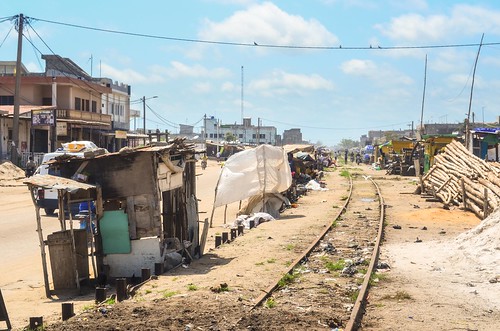
The first special impression I have is that there are more moto taxis than anything else. They are called zems or zemijohns. There is practically no taxi in Cotonou, only motorbikes.
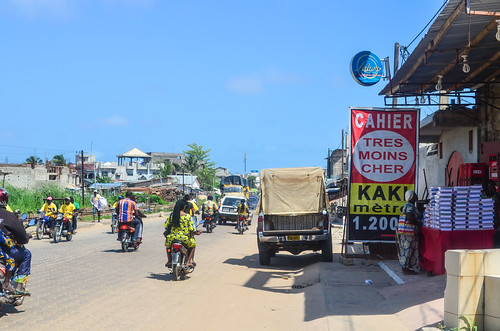
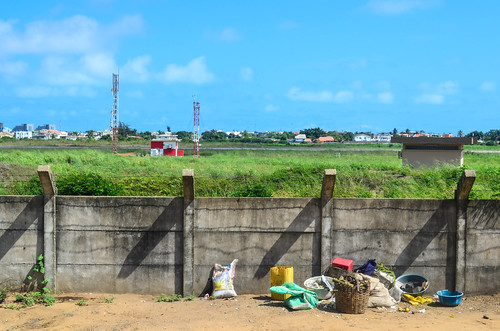

I arrive to a guesthouse close to the airport, in the nice area of Haie Vive. It has all the fine restaurants for expats and the embassies. But sadly, I am experiencing my first diarrhea of the whole trip. After drinking all that water from anywhere and eating on the streets, I can’t say it is surprising. But it doesn’t last long.
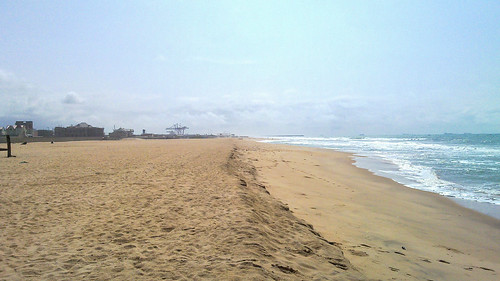
The Nigerian Embassy is open for visa applications only 2 days a week. After failing to get a visa in Accra (where it is totally impossible for travelers, confirmed by Johannes who applied unsuccessfully with more documents than I did), I am using my last chance in Cotonou.
So the next day, on Tuesday morning, I show up at the Embassy. How unlucky do I need to be for the Nigerian Independence Day (October 1st) to occur just this day? I must retry in two days. In the meantime, I walk on the beach until the nearby hypermarket. The beach is empty, attracting no one. The sea is often rough on the Atlantic coast and beaches are not enjoyed. There is definitely the potential for something though.
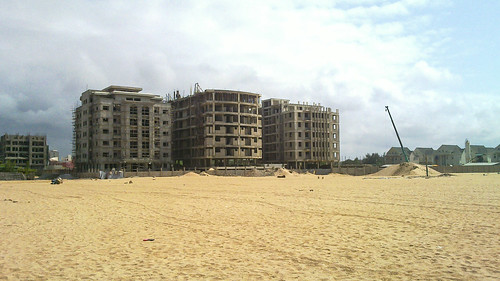
I reach the Erevan hypermarket, which is decorated the same way a Hyper U is decorated. It is actually very much a Hyper U, like in France, with the very same products. It is not the first time I visit supermarkets of imported products in African capital cities, but this one is different: it is huge. It is very clean, and if I were teleported in it, I would not notice I am in Africa. There are endless shelves of wines bottles. There is fois gras and even craquinettes. There is also Baton de Berger (10 € for 250 g) and Morbier cheese (30 € / kg). It is said to be the largest supermarket of West Africa, and could really be.
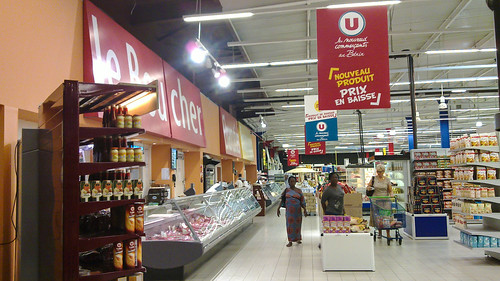
My second visit to the Nigerian Embassy unfolds very pleasantly. The welcome is professional, my documents (the same big file I had prepared for Accra) are accepted during the short interview, and I am given a beautiful receipt when I pay no more than the official fee. I push to ask for the longest visa I can.

I can later pick up my visa, 3-month multiple entry starting from the day of entrance into Nigeria. After the hassle of the Embassy in Accra, it feels like a victory to finally get it. It is now time for a little rest.







Tres belles photos, tes commentaires sont tres fideles aux realites d’ici. Bravo a toi, et merci. Pierre, Benin